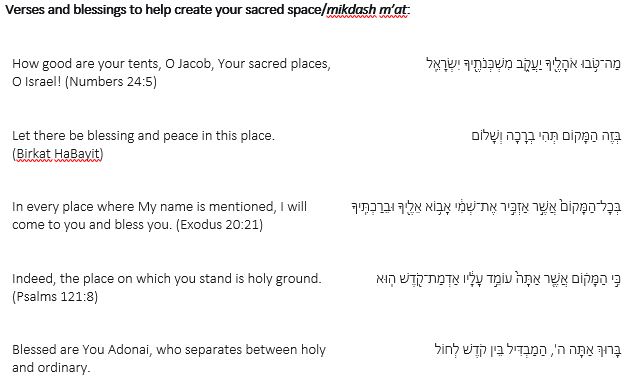 Setting Up a Sacred Space at Home Adapted from Rabbi Elyse Goldstein (City Shul, Toronto)
Setting Up a Sacred Space at Home Adapted from Rabbi Elyse Goldstein (City Shul, Toronto)
With the current pandemic, our kitchens have become our classrooms, our basements are our yoga studios, and our dining rooms are now our offices. Where then, is our synagogue? The rabbis asked this same question right after the destruction of the Temple. Without a localized place of worship, how could we pray together? We are the inheritors of their answer: our home would become our mikdash m’at, a miniature sanctuary, a holy place.
This year, we have a unique opportunity to create a sacred space in our homes— a mikdash m’at—for the High Holidays and beyond. The suggestions below are meant to help you create a sacred space at home, to use while live-streaming services or for any other time of prayer.
- Choose your prayer space in advance. Don’t wait for the last minute! You’re looking for a space where everyone can sit comfortably and can easily see the screen. If layout allows, consider facing east, in accordance with the tradition of praying in the direction of Jerusalem.
- Once you have chosen your space, say a blessing over it (such as the blessing from havdalah about separating the holy and from the ordinary) or set a kavannah (intention) to mark it as your mikdash m’at. Suggestions of verses and blessings are below.
- Many synagogues have a decorative, calligraphic wall-hanging called a shiviti (taken from the first Hebrew word of the verse, “I always set HaShem before me” (Ps. 16:8)). You can create your download your own shiviti poster to hang on your wall here (Note: To print on 8.5 x 11 paper, make sure to resize the image to letter-size in the print settings. Click here to download.) You can also make your own shiviti using one of the verses below, or another one of your choosing.

- What will you be sitting on? Put a cushion or festive pillow on your chair or couch, or drape your seating with a tallit, special fabric, or scarf.
- Cover the surface underneath your computer with a white tablecloth or place-mat. Set a vase of flowers by your screen.
- Find meaningful objects to grace your space. On Rosh HaShanah, you could include holiday objects like candlesticks, a Kiddush cup, or apples and honey. On Yom Kippur, you might place cherished mementos, family heirlooms, and photos of loved ones in front of you. If you own a shofar, put it where it’s visible.
- If possible, move the computer back so that you are “watching” the screen more than “manipulating” it. Or consider connecting your computer to a TV screen, so that people can see the screen more easily.
- Limit other distractions. Close your email and other computer programs; turn off alert sounds.
- Wear clothing that makes you feel as if you are entering a spiritual space.
- Be sure you have your machzor with you, just like on past High Holidays when we gathered. As you feel its cover and edges and flip its pages, remember the times you’ve used it before—who you sat near, what moved you in the service, what the weather was like. If you’re using an online copy of the mahzor, make sure to plan in advance so you know where to find the prayers you will be following.
- If you have young kids, ask them to build a blanket- or pillow-fort, or use a camping tent, to create their own ohel mo’eid (tent of meeting) for watching services. Stock the tent with any supplies (books, toys, snacks, etc.) they might want during services. They can also bring some stuffed animals to watch services alongside them.

May your sacred space add joy and meaning to your High Holidays and beyond.
 Setting Up a Sacred Space at Home Adapted from Rabbi Elyse Goldstein (City Shul, Toronto)
Setting Up a Sacred Space at Home Adapted from Rabbi Elyse Goldstein (City Shul, Toronto)
